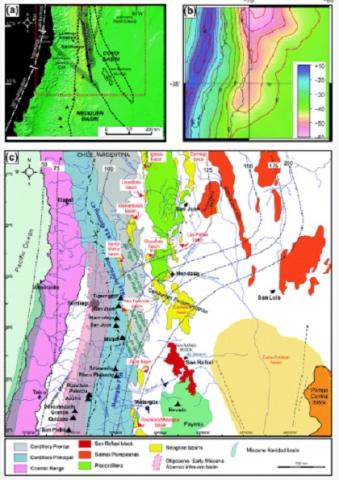Laura Giambiagi, José Mescua, Florencia Bechis, Gregory Hoke, Julieta Suriano, Silvana Spagnotto, Stella Maris Moreiras, Ana Lossada, Manuela Mazzitelli, Rafael Toural Dapoza, Alicia Folguera, Diego Mardonez, Diego Sebastián Pagano
2 015
Part of the Springer Earth System Sciences book Growth of the Southern Andes pp 63-98
This review explores the complex interactions of endogenic and exogenic processes in the segment of the Andes that straddle a transition from the Pampean flat slab to a normal subduction segment (32°–36°S). This segment shows remarkable along-strike variations in topographic uplift, structural elevation, amount and rate of shortening, and crustal root geometry. In the flat-slab segment, high elevations, the development of several tectonic provinces (mountain systems) and the lack of active volcanism characterize the orogen. Deformation and uplift advanced to the east, together with arc-related magmatic activity, sequentially uplifting the Principal Cordillera (20 to ~8 Ma), the Frontal Cordillera (12–5 Ma), the Precordillera (<10 Ma) and the Sierras Pampeanas (<5 Ma). In the normal subduction segment to the south, the Andes are characterized by a decrease in elevation, with a big step in topography at ~35°S and the development of an active magmatic arc straddling the Argentina-Chile border. The Frontal Cordillera is only in the northern part of the normal subduction segment, disappearing at 34°S; only the Principal Cordillera remains south of this latitude. Similarly, deformation progressively advanced to the east, uplifting the Principal Cordillera (20–8 Ma), the Frontal Cordillera (<10 Ma) and the San Rafael basement block (<5 Ma). The amount of shortening systematically decreases from north to south along these two segments, but at the transitional zone between flat and normal subduction zones, there is a sharp decline from ~180 km of shortening (32°S) to ~70 km (33°40′S). South from this latitude, the amount of shortening lineally decreases until it reaches ~30 km at 35°S. Yet, interestingly, the amount of late Miocene surface uplift is opposite to the trend in crustal shortening. These along-strike variations are best explained by boundary conditions of the subduction system related to interplate dynamics controlling the overall pattern of tectonic shortening. However, local variations in mean topographic elevation, deformation styles and crustal root geometry are more likely to be due to upper-plate lithospheric strength variations. These strength variations have governed the coupling degree between brittle upper crust and ductile lower crust deformation. In the flat-slab segment, an initial thick and felsic crust favors the coupling model; while in the normal subduction segment, a thin and mafic lower crust allows the uncoupling model.

